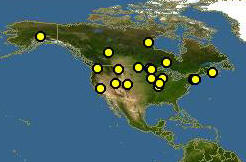Habitat
Stagnicola elodes is a freshwater snail that can be found in many regions of the United States and Canada. As you can see on the Discover Life map, Stagnicola elodes lives in Washington, California, Iowa, New York, Massachusetts, as well as Alberta and Ontario, and also in Alaska (NatureServe, 2010). According to Burch(1989), this species ranges from Oregon east to New England, California south to New Mexico, and it is widely distributed in the Canadian Interior Basin. Stagnicola elodes is also found in south and central Mexico (NatureServe, 2010).
This species is commonly known as the marsh pondsnail because it
is found in marshes and ponds. Eva Pip observed a very high
prevalence of Stagnicola elodes in ponds while
doing research in Canada (Pip, 1985). A population of
Stagnicola elodes was observed in Oakland County, Michigan
by Jokinen and the adults mostly lived in the water (Jokinen,
1977).
However, when they laid eggs, once the young reach 2-7mm in
length, they leave the water and estivate on the ground near tree trunks and grasses
(Jokinen,
1977). Once winter comes along, the young snails leave the above-ground and they live under leaf
litter until spring (Jokinen,
1977). During that time, the older snails stay
along the dry pond floor, where they are easily preyed upon.
When spring arrives and the ice melts, they juveniles
return to the lake with the adult snails (Jokinen,
1977).
When Pip surveyed areas in Canada, Stagnicola elodes was observed with many other snails, but S. elodes was the one species that lives in the least diverse communities (Pip, 1985). Stagnicola elodes showed higher affinities for levels of pH between 6.7 and 9.5, total alkalinity mean of 165, total nitrate and nitrite mean of 1.53, and total dissolved solids (Pip, 1985). When in habitats of low pH and low values of dissolved inorganics, Stagnicola elodes does not adapt well and cannot compete with species that are are more specialized in those habitats (Pip, 1985). Situations such as these means the snail is under stress. Due to the stress, Stagnicola eldoes does not acclimating well to many different environments, and thus a possible reason for rarity in certain waters of Canada (Pip, 1985).
